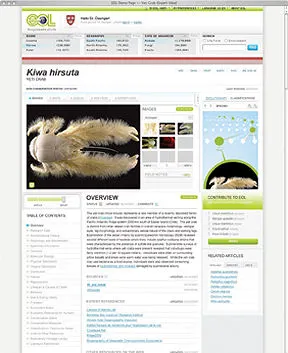An international team of weighty institutions this week announced that it’s developing the weightiest encyclopedia of biology yet. The free, multilanguage, Web-based guide will cover the 1.8 million living species known, plus new discoveries, say researchers from the Smithsonian Institution, Harvard University, the Field Museum in Chicago, and other organizations.

The John D. and Catherine T. MacArthur Foundation is putting up $10 million for the project, and the Alfred P. Sloan Foundation is adding $2.5 million. If the project meets its goals for the next 2.5 years, those foundations will repeat their grants. Also, the six institutions that started the project have pledged to raise $50 million for the work.
The Encyclopedia of Life (EoL) will combine the authority of a traditional print behemoth with the collaborative spirit of the Web’s user-created Wikipedia, says James Edwards, EoL’s Washington, D.C.–based executive director. In the Wiki spirit, EoL will eventually have a section inviting contributions from everyone, says Edwards.
At first, the creators will take information from established scientific databases and present it in the EoL format. As the project grows, says Edwards, bird-watchers will be invited to record their sightings, and gardeners will contribute the first dates for blooms.
The EoL team is planning to offer special tools to school classes studying their neighborhoods. Combining all sources, a species’ entry might include its genetic sequence, recordings of noises it makes, and videos of it “doing something interesting,” Edwards says.
The encyclopedia’s creators also say that they want to supply the authority of traditional print volumes. Scientists will approve certain content, and viewers will have the option of filtering out entries that haven’t been reviewed.
The prototype pages (http://www.eol.org) show that viewers may also set the level of complexity they’ll encounter. On a polar bear page, a “novice” setting reveals basic biology suitable for a school report. Meanwhile the “expert” viewer will find—from an original 1774 document—Constantine John Phipps report that “feamen” exploring the Spitsbergen islands of Norway ate bear meat but found it “exceeding corfe.”
Easing access to such literature could help taxonomists in the “tedious” parts of describing species, says David Patterson, a taxonomist and biodiversity-informatics specialist at the Marine Biological Laboratory in Woods Hole, Mass., an EoL partner. Collecting descriptions of related organisms for analysis sometimes takes years. Patterson adds that he hopes EoL will encourage taxonomists to use electronic tools.
Eminent biologists such as E.O. Wilson have been calling for a grand encyclopedia of life for years, but Patterson says that only recently have new Internet tools made it feasible. The first pages should be available in 2008, and the 1.8 million basic entries could be online as early as 2017.







